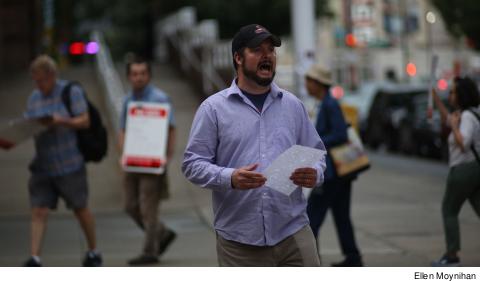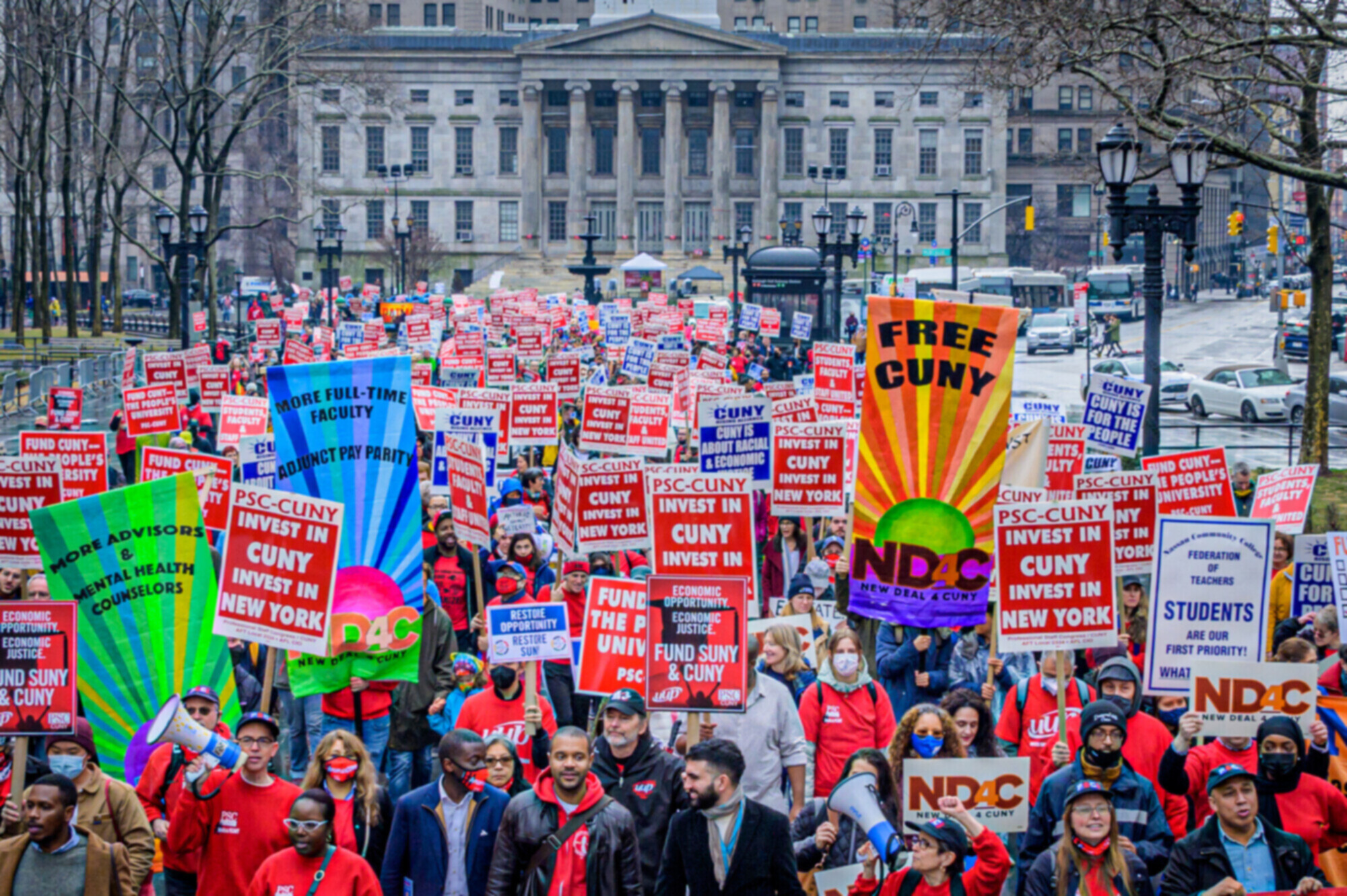PSC field staff talk about organizing
 |
With nearly 30,000 members spanning more than 25 CUNY campuses and work sites across the city’s five boroughs, PSC’s seven-person organizing staff has a lot of territory to cover – and they are essential to the work of a union like the PSC that locates its power in the collective force of its members.
“When we took office, the PSC didn’t have a single organizer on staff,” said PSC President Barbara Bowen. “We changed that immediately, because increasing the union’s political leverage requires organizing thousands of members to act together. Now the union has an exceptionally talented organizing staff, some with PhDs and all of whom have significant experience in the labor movement or social justice organizing.”
DOING IT ALL
Organizers are the union staff whom members often see on campus – meeting with newly hired faculty and staff, identifying members’ issues and training PSC members to have workplace conversations with their coworkers. They carry signs and AV equipment at protests, set up chapter meetings, conduct one-on-one member meetings and hunker down in the PSC office managing spreadsheets and other materials.
“One of the big challenges we face as a union is strengthening our department rep[resentative] structure,” said Deirdre Brill, the PSC organizing director, who has worked at the union for more than a decade and has led the department since the summer of 2012. “Our work, which aids the PSC’s ability to grow and sustain membership levels in the face of extreme and growing casualization of academia, will determine our strength as a union.”
Brill is no stranger to labor or the academy. She has a PhD in history from the University of Pennsylvania and taught at Rutgers University for a year as a lecturer. Brill also worked on adjunct organizing campaigns prior to joining the PSC as part of the American Federation of Teachers Northeast Regional Organizing Project.
The Supreme Court decision Janus v. AFSCME forbids public-sector unions from collecting “agency shop” fees from non-members. As a result, every newly hired member of the bargaining unit – whom the PSC represents – must make an individual decision to join and pay dues to the PSC. The situation puts unions like the PSC in a constant state of organizing newly hired faculty and staff, training existing members in outreach to new employees and urging non-members to sign union cards.
The mission of the organizing department remains constant: to build “collective power” and recognize “the fundamental importance of collective action in confronting unaccountable institutional power,” according to the department’s mission statement. At CUNY, this means organizing on multiple fronts that include pressuring for a good contract, pushing for more CUNY funding on health and safety issues, timely payment for adjuncts and a host of other contract enforcement issues.
“One of the major challenges right now is all of the health and safety issues our members are confronting. There are buildings undergoing major construction, leaky ceilings and mold and extremely cold or hot offices. We’re trying to deal with those in an environment where regulations are often incomplete or lax and allow CUNY to hide behind the fact that they are ‘complying with the law,’” said Brian Graf, a PSC organizing coordinator who also works with the PSC Health and Safety Watchdogs.
ADDRESSING SAFETY
In the past few years, organizers have addressed health and safety problems at CUNY, including a situation where faculty were teaching in makeshift laboratories and constantly suffering problems from dust and debris due to ongoing construction at Baruch College’s 17 Lexington Avenue building. In another situation, hundreds of classes needed to be relocated at the beginning of the semester because of a series of pipe bursts at Bronx Community College. Graf said that it is encouraging to see more and more union members realize that they should not accept these substandard working conditions.
“It’s also encouraging that more and more rank-and-file members are realizing they need to stand up for themselves and become active on these issues,” Graf said.
While talking to members at Queens College, Sam Rasiotis found a potential contract violation: an adjunct who attended a mandatory workplace violence training was not paid for the time. Rasiotis ended up working with PSC’s contract enforcement department to file a class action grievance.
“I emailed all the adjuncts at Queens College asking, ‘Have you been invited to this? Have you not been paid?’ A bunch wrote me back, and we went through and figured out who qualified and who didn’t,” Rasiotis said.
In the end, the union won and the qualified adjuncts were paid. While the win may seem small – around $60 per adjunct – it meant something to members to see the results of their collective action. The successful grievance also helped to support contract negotiations leading to fully paid “professional hours” for teaching adjuncts.
Because CUNY faculty and staff are politically active in many causes and not just the union, one challenge is engaging members to be active in the PSC.
MAKING THE UNION VISIBLE
“We have to work really hard to make the union the place where they practice their politics,” said Sam Lewis, an organizer who previously worked at New York Communities for Change. “I think it’s about the union being really visible and active on campus.”
Eric Paul, an organizing coordinator who has a PhD in history and who has taught as a faculty member and worked as a community organizer in an immigrant rights organization prior to coming to the PSC, said, “It is always a challenge to get people to take that first step of talking with coworkers and taking collective action, due to apathy, fear, or fatalism, but many members do. It starts at a chapter meeting, in a hallway conversation or an office visit.”
CONNECTING ONE-ON-ONE
For Jorge Guzman, an organizer who started off as a rank-and-file nursing home worker, a key aspect of organizing is connecting with workers individually.
“When I was in healthcare organizing, I had to do a lot of one-on-ones and go to hospitals and sit in cafeterias and just talk to people,” said Guzman, who has more than seven years’ organizing experience working with nursing home workers, maintenance staff and custodians. He said an organizer has to hear and understand workers’ issues, said Guzman.
“You might not think that it’s a big issue, but if it affects them a lot, it’s a big issue for them. I’ve learned that there are no small issues.”
One of the challenges in organizing is bringing together people who have different points of view, people who do not necessarily agree with you, said Janet Kwon, a PSC organizer who has worked at a workers’ center in Koreatown in Los Angeles and at the New York Taxi Workers Alliance. Kwon, who is the newest organizer on PSC staff, said, “It’s amazing that there’s such high membership. People should take ownership of the fact that CUNY relies on their labor. They actually do have a lot of power, and by mobilizing and acting collectively, that’s how they are going to win more.”
If you have a workplace concern, contact the PSC organizer assigned to your campus or work site. Organizing staff contact information is found at the bottom of this webpage.

